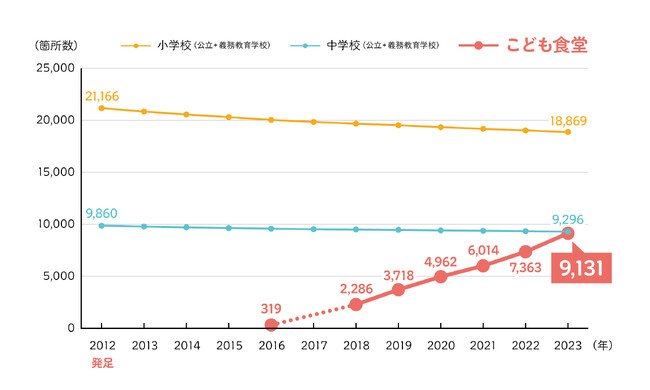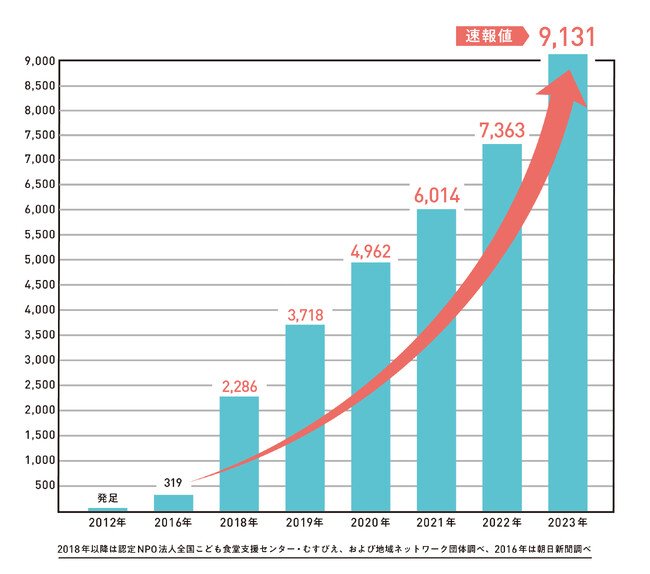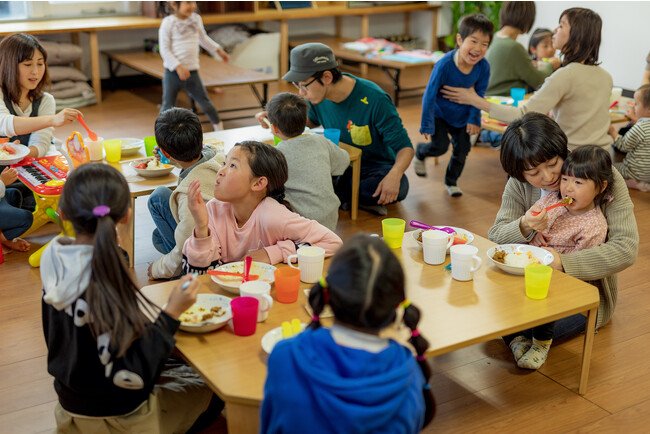Certified NPO Nationwide Children’s Cafeteria Support Center/Musubie The number of children’s cafeterias has increased to 9,131, almost equal to the number of public junior high schools nationwide – Announcement of the results of the 2023 survey of the number of children’s cafeterias nationwide – (Preliminary figures as of December 2023)
……
“Certified NPO National Children’s Cafeteria Support Center Musubie (Musubie)” (Shibuya-ku, Tokyo, Chairman: Makoto Yuasa) works to realize a society where no one is left behind through support for children’s cafeterias. , has announced preliminary figures for 2023 regarding the “Survey on the Number of Children’s Cafeterias Nationwide” that began in 2018.
The survey was carried out with the cooperation of local network organizations that support children’s cafeterias across the country. According to the 2023 survey, the number of children’s cafeterias nationwide increased by 1,768 from last year to 9,131, which is almost on par with the total number of public junior high schools and compulsory education schools in Japan, which is 9,296 (*1). This is the largest increase since the survey began in 2018.
*1 From the Ministry of Education, Culture, Sports, Science and Technology’s “FY2020 School Basic Survey (preliminary figures)” -Graph 1- Changes in the number of children’s cafeterias and the number of elementary schools/junior high schools nationwide
[Image 1

・From 2018 onwards, according to the certified NPO National Children’s Cafeteria Support Center, Musubi, and local network organizations, and from 2016 according to Asahi Shimbun ・The number of elementary schools and junior high schools is based on the Ministry of Education, Culture, Sports, Science and Technology’s 2021 School Basic Survey (preliminary figures) Based on the total number of public
elementary/junior high schools and the number of public compulsory education schools.
-Graph 2- Changes in the number of children’s cafeteria locations [Image 2

Musubie’s mission is to “create an environment where children’s cafeterias can be found anywhere in the country and where everyone can go with peace of mind,” and by 2025, we aim to open at least one children’s cafeteria in every elementary school district (*2). We are aiming for a state where there is a children’s cafeteria. This survey has been conducted every year since 2018 as a research project to realize this goal. This survey was conducted by Musubie with the cooperation of all parties involved in children’s cafeterias, including local network organizations for children’s cafeterias nationwide, prefectural offices, and prefectural social welfare councils. However, since children’s cafeterias are private activities that do not require notification to local governments, there is a possibility that not all information is covered. In that sense, the numbers show that we have been able to confirm at least this far. *2 As of May 2023, there are 18,869 schools. From the Ministry of Education, Culture, Sports, Science and Technology’s “FY2020 School Basic Survey (preliminary figures)”
[Image 3

■ The number of children’s cafeterias will increase by 1,768 from 2022 to 9,131. This is the largest increase ever, even before the coronavirus pandemic, and the number is almost on par with the number of public junior high schools nationwide.
[Survey overview] Period: September 2023 to November 2023 Method: In addition to filling out the survey form, confirmation by phone Target: Prefectural government, prefectural social welfare council, and all other parties involved in children’s cafeterias Cooperation: Regional network groups *Some members made phone calls to individual
municipalities and social cooperatives (see Appendix 1 for respondents by prefecture). *As mentioned earlier, children’s cafeterias are private activities that do not require notification to local governments, so there is a possibility that not everything is covered. In that sense, it should be noted that the numbers indicate that at least this much has been confirmed.
[Result points]
In the 2023 survey, there was an increase of 1,768 locations, which was the largest increase ever, even before the coronavirus. The total number of locations is 9,131, which is almost on par with the total number of public junior high schools and compulsory education schools nationwide, which is 9,296.
There are three possible reasons for this increase: 1) The move to ease coronavirus countermeasures was influenced by the transition of coronavirus to a “Type 5 infectious disease” on May 8, 2023. It can be said that the “power to flexibly overcome difficulties and recover” by people who have experienced the prolonged coronavirus pandemic, who are trying to regain connections with their local community through children’s cafeterias, has led to the largest increase in the number of children on record. 2) In April 2023, the Children and Families Agency will be established, and guidelines for children’s places will be approved by the cabinet (planned), and there is a growing interest in creating places for children by the national and local governments. 3) Children’s cafeterias run by companies are also expanding. The largest number of locations was Tokyo at 1,009 locations (over 1,000 locations for the first time), second place was Osaka Prefecture at 757 locations, and third place was Hyogo Prefecture at 521 locations. The top two prefectures remain unchanged from 2022, and the top third place has changed from Kanagawa to Hyogo. On the other hand, the least number of locations were Akita Prefecture with 38 locations, Fukui Prefecture with 41 locations, and Nagasaki Prefecture with 48 locations.
The largest increase was in Tokyo at 170 locations, followed by Osaka Prefecture and Hyogo Prefecture with 144 locations. In terms of increase rate, the top three prefectures were Ishikawa Prefecture at 91.30%, Okayama Prefecture at 54.84%, and Tokushima Prefecture at 54.17%.
The national average of the sufficiency rate (school district implementation rate) for elementary school districts was 30.56%, exceeding 30% for the first time. The top three prefectures were all over 50%, with Okinawa at 56.70%, Tottori at 54.62%, and Tokyo at 51.26%. On the other hand, the sufficiency rates were low in Nagasaki Prefecture at 13.10%, Akita Prefecture at 15.34%, and Fukui Prefecture at 17.89%.
Furthermore, although the sufficiency rate (school district
implementation rate) is an important indicator, the sufficiency rate may appear to be higher in prefectures where consolidation of elementary schools is progressing. The number of children’s cafeterias per 10,000 people is also announced. In terms of population ratio, “Okinawa Prefecture” (21.27 locations) was ranked high, followed by “Tokushima Prefecture” (15.44 locations) and “Tottori Prefecture” (15.19 locations). On the other hand, “Nagasaki Prefecture” (3.68 locations), “Akita Prefecture” (4.04 locations), and “Chiba
Prefecture” (4.61 locations) had a low population ratio.
For details on the key points of the 2023 National Children’s Cafeteria Survey, please see Document 1. Please see “Reference 3” for comments from the local community.
[Survey materials]・Material 1: Key points of the 2023 nationwide survey on the number of children’s cafeterias
https://musubie.org/wp/wp-content/uploads/2023/12/siryo_1.pdf・Document 2: List of number of locations, filling rate, etc. by prefecture https://musubie.org/wp/wp-content/uploads/2023/12/shiryo_2.pdf・Material 3: Comments from each prefecture
https://musubie.org/wp/wp-content/uploads/2023/12/shiryo_3.pdf・Attachment 1: Breakdown of respondents and sufficiency rate/population ratio by prefecture
https://musubie.org/wp/wp-content/uploads/2023/12/betsu_hyou_1.pdf・Attachment 2: Prefecture ranking by survey index
https://musubie.org/wp/wp-content/uploads/2023/12/betsu_hyou_2.pdf [Other: Materials from the announcement on December 14, 2023]・“What I most want to tell you today” (December 14, 2023 Musubie Chairman Makoto Yuasa) https://musubie.org/wp/wp-content
/uploads/2023/12/Honjitsu_20231214.pdf
◆ ◇ ◆
Ishikawa Prefecture, which ranked first in terms of increase rate in FY2023, made the following comments in response to the results of the number of locations survey.
—
“As of the end of fiscal 2022, there will be approximately 70 children’s cafeterias in the prefecture (according to city and town surveys).On the other hand, five municipalities have not established one. From this fiscal year, we will be providing “opening preparation support” to subsidize the initial hosting costs, “dispatch of advisors” to provide know-how to children’s cafeteria operators, and “matching support” with support companies that will supply
ingredients. We provide support to private organizations that are trying to set up children’s cafeterias in three packages. In the future, the prefecture will continue to work together with local communities to establish children’s cafeterias in familiar areas throughout the prefecture. (Ishikawa Prefecture Health and Welfare Department, Declining Birthrate Countermeasures Office, Childcare Support Division)
—
In addition, a representative of a regional network organization in Ishikawa Prefecture commented as follows.
—
“Our club has been moving forward with the slogan “One children’s cafeteria in every elementary school district!” ever since we held the 2017 nationwide tour of children’s cafeterias in Ishikawa Prefecture. Distributing gifts and food waste to children’s cafeterias in Ishikawa Prefecture, sharing information on donations and subsidies, front-page newspaper advertisements for children’s cafeterias during the coronavirus pandemic, and holding on-site children’s cafeterias. Some children’s cafeterias not only provide food, but also serve as a place for children to learn and notice the yellow flags when it comes to raising children, and an increasing number of governments are supporting this. This led to widespread recognition of the children’s cafeteria. We will continue to devise ways to provide support so that each children’s cafeteria can easily hold regular events, and so that they do not have to give up their own money or attract prejudice. ” (Kanazawakko Nikoniko Club Kiyoe Kiyoshi)
◆ ◇ ◆
[What is a children’s cafeteria?] Regardless of its name, such as community cafeteria or Minna no Ie, it is a free or low-cost cafeteria where children can come by themselves with peace of mind. There are two major axes: “Countermeasures against child poverty” and “Community exchange base.”・What we value
https://musubie.org/precious/
[About the National Children’s Cafeteria Support Center/Musubie, a certified NPO] Representative: Chairman Makoto Yuasa (social activist, Specially Appointed Professor at the Research Center for Advanced Science and Technology, University of Tokyo, member of the Association of Corporate Executives, Children’s and Family Affairs Agency, Children’s and Families Council, Children’s Affairs) Location: Link Square Shinjuku 16F, 5-27-5 Sendagaya, Shibuya-ku, Tokyo Established: December 2018 (Certified NPO in May 2021, Good Governance
Certification in October of the same year) The vision is “Through support for children’s cafeterias, we will create a society in which no one is left behind.” In order to achieve this goal, children’s cafeterias can be found anywhere in the country, and we will create an environment where everyone can go with peace of mind. We work to enable people to participate in social activities that will shape the future. Specifically, we will carry out research and research to clarify the actual situation of children’s cafeterias, disseminate and raise awareness, regional network support projects to support children’s cafeteria networks in each region, and collaborative projects between companies and organizations that support children’s cafeterias. Is going. In fiscal 2022, in addition to providing grants of approximately 520 million yen to a total of 1,302 organizations, we also mediated material support of approximately 530 million yen (sales price calculation) to 11,052 organizations.
■The image data on this site can be used for media-related purposes. If you wish to use this service, please contact the contact
information below regarding this matter.
[Contact information]
Certified NPO Nationwide Children’s Cafeteria Support Center/Musubie Homepage: https://musubie.org/
Inquiry email: pr@musubie.org (public relations)
